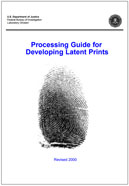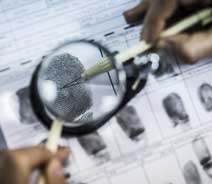|
View in browser: https://www.crime-scene-investigator.net/newsletter/0421.html
|
||
|
APRIL 2021 | ||
| ||
|
This Month's Featured Resource on the Crime Scene Investigator Network Website
|
||

The beginning of this manual is a list of processes and procedures for different surface types. Also included are processing sequences that specifically involve prints that are left in blood. Following these lists are details for each process that is currently implemented in the Latent Print Unit (LPU) of the Federal Bureau of Investigation (FBI) Laboratory. |
||
|
Featured Video Presentation
|
||
|
Learn the basic technique for processing latent fingerprints by dusting with black powder. |
New CSI and Forensic Job Announcements
|
|
|
The most comprehensive listing of Crime Scene Investigation and Forensic To be notified of job openings as they are posted, follow us on Twitter: Job Posting Alerts |
||
|
Crime Scene Specialist
Travis County Sheriff, Austin, Texas, USA Final Filing Date: April 23, 2021 Responds to crime scenes, identifies and documents evidence, and collects and processes physical evidence. Photographs and sketches of physical evidence at the scene of the crime. Transports and stores evidence. <View complete job listing> |
||
|
Crime Scene Investigator
Huntington Beach Police Department, Huntington Beach, California, USA Final Filing Date: April 30, 2021 Conducts investigations on crime scenes, deaths, serious traffic accidents, industrial accidents and other crimes; documents and gathers evidence; and examines evidence in both field and laboratory for latent fingerprints using print powders, chemicals and laser techniques. <View complete job listing> |
||
|
Property/Evidence Technician
South Lake Tahoe Police Department, South Lake Tahoe, California, USA Final Filing Date: May 17, 2021 Perform a wide variety of duties including performing crime scene investigations, evaluating and processing evidence, examining latent fingerprints, and maintaining the property room. <View complete job listing> |
||
|
Property & Evidence Specialist
Doral Police Department, Doral, Florida, USA Final Filing Date: April 22, 2021 Responsible for the receipt, storage, issuance and safeguarding of a variety of property and evidence confiscated through law enforcement activities. Work involves the keeping of detailed records for all property and evidence issued and received. <View complete job listing> |
||
 |
||
|
Associate Forensic Scientist
Arizona Department of Public Safety, Phoenix, Arizona, USA Final Filing Date: April 25, 2021 Receives extensive training in relevant forensic science areas in order to become proficient in crime laboratory procedures. Utilizes chemical, microscopic, chromatographic and comparative techniques and instrumentation to examine, identify and evaluate physical evidence which may include: controlled dangerous substances; blood, urine and other biological specimens; firearms; questioned documents; latent prints; trace evidence; and other items of evidentiary value. <View complete job listing> |
||
|
Toxicologist 1
Institute of Forensic Sciences, Houston, Texas, USA Final Filing Date: May 1, 2021 The Toxicologist 1 is an early-career forensic toxicologist, expected to operate analytical instrumentation, critically assess analytical data, report test findings, and render expert opinions and testimony in court concerning tests performed in the laboratory. <View complete job listing> |
||
|
Crime Lab Technician I
Baltimore Police Department, Baltimore, Maryland, USA Final Filing Date: May 25, 2021 A Crime Laboratory Technician I learns to perform specialized crime laboratory work such as evidence detection, criminalistics, firearms, latent print examination or crime laboratory and crime scene photography. <View complete job listing> |
||
|
Forensic Investigator I or II
Cobb County Medical Examiner, Marietta, Georgia, USA Final Filing Date: April 20, 2021 Secures death scenes: examines body and scene for clues and evidence to determine cause of death; takes photographs; collects, evaluates, and preserves evidence, including biological samples; maintains control and chain-of-custody over physical evidence gathered; ensures proper handling, packing, and transport of evidence; and coordinates transportation of body to morgue or funeral home. <View complete job listing> |
||
|
Search for more job listings in Crime Scene Investigations and Forensics To be notified of job openings as they are posted, follow us on Twitter: Job Posting Alerts |
||
|
Other Resources on the Crime Scene Investigator Network Website
|
||
|
Not Subscribed to this Newsletter?
|
||
|
If you are not subscribed to this newsletter, you may subscribe with this link: SUBSCRIBE via email |
||
|
To Unsubscribe
|
||
|
To unsubscribe from future e-mail alerts, please click here: UNSUBSCRIBE Copyright ©2021 Crime Scene Resources, Inc. Crime Scene Investigator Network |

 It was alleged that the defendant Mitchell's fingerprint was found on the getaway car used in an armored car robbery. This case was significant in that it was the first challenge as to the validity of fingerprint identification in light of the standards for expert testimony as set forth in the 1993 United States Supreme Court decision in Daubert v. Merrill Dow Pharmaceuticals, 509 U. S. 579, 588 (1993) in which the court discussed four basic factors in regard to scientific testimony: (1) Testing (2) Peer review (3) Error rates and (4) Acceptability in the relevant scientific community. Trial judges were also given the responsibility of being gatekeepers to bar junk science from entering the courtroom.
It was alleged that the defendant Mitchell's fingerprint was found on the getaway car used in an armored car robbery. This case was significant in that it was the first challenge as to the validity of fingerprint identification in light of the standards for expert testimony as set forth in the 1993 United States Supreme Court decision in Daubert v. Merrill Dow Pharmaceuticals, 509 U. S. 579, 588 (1993) in which the court discussed four basic factors in regard to scientific testimony: (1) Testing (2) Peer review (3) Error rates and (4) Acceptability in the relevant scientific community. Trial judges were also given the responsibility of being gatekeepers to bar junk science from entering the courtroom. 

